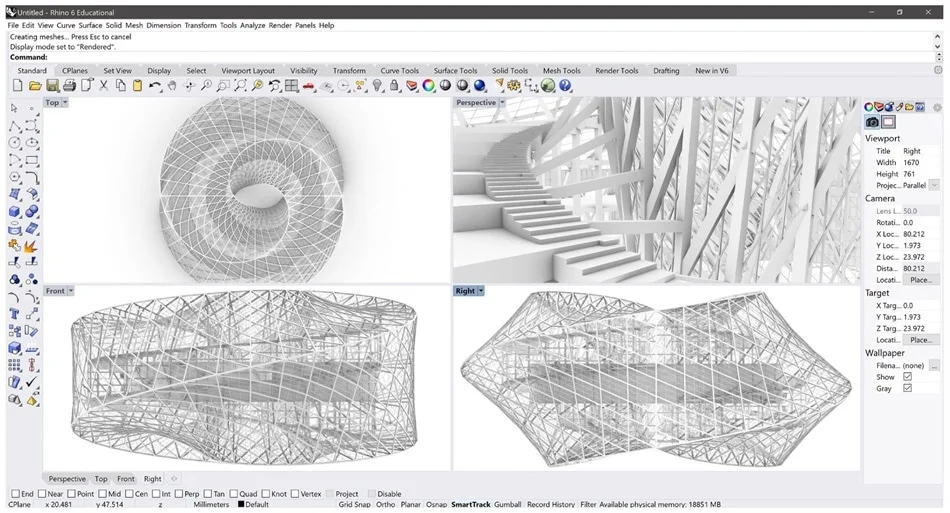Algorithmic VR Design to Help Architects Make Instant Design Alterations
- Technology
- May 19, 2022
Present architectural digital interpretation tools implement a visualization strategy that reflects the building’s form through the use of plans, sections, elevations, and perspective views. A study presented in the journal Architecture considers the use of Algorithmic Design in Virtual Reality to facilitate the design stage of planning.
Virtual Reality (VR) technology can significantly improve modeling and theorization processes by allowing users to acquire the building and consider it at its natural scale. However, despite the benefits VR has for architectural design, it has a significant drawback: major aspects of ideas proposed during a VR session cannot be incorporated or tested during that session. In fact, most strategies to change the design, with or without VR, are restricted to manual model manipulation and, as a result, cannot have a large influence on the design.
Algorithmic Design (AD) addresses this issue by describing the model algorithmically, allowing parametric changes to the design while preserving its internal logic, guaranteeing the uniformity of the modified design. However, because AD has yet to be used in conjunction with VR, designers are unable to update the algorithmic descriptions of their models while engrossed in a Virtual Environment (VE).
To improve this issue, researchers propose Algorithmic Design in Virtual Reality (ADVR) in this paper, a workflow based on the use of algorithms to portray designs that allows for comprehensive design changes while engrossed in VR. Architects can instantly experiment with design variations using ADVR without departing the VE.
Figure 1 depicts this scenario for the Astana National Library (ANL) project. This building, designed by Bjarke Ingels Group in 2008, is in the shape of a 3D Moebius strip, a rather complex form that can only be understood through projections.

AD is the process of creating architectural designs using algorithmic descriptions that are then executed as computer programs. Figure 2 depicts multiple varieties of the ANL model obtained by varying the radius of the central plaza and the torsion of the building’s facade.

Live coding is a method that involves creating interactive programs on the go. In the case of virtual reality, researchers visualize the use of live coding in a scenario in which the architect can code the algorithmic description of the model alongside the subsequent geometry.
The idea of using VR for coding is not new. The Primitive tool, for example, has demonstrated the use of virtual reality (VR) for collaborative software analysis visualization. VR-specific coding applications have also been created.
Methodology
Although it is feasible to manipulate code in VR using the interaction techniques provided in visual programming, the intricacy of the models that gain the most from immersive visualization makes this an unviable approach.
Researchers propose that a textual-based AD methodology, which permits large design revisions out of the box, be combined with VR, an innately interactive and immersive medium, to enhance the design experience. The following describes ADVR, a way of interacting with textual AD programs and models in virtual reality. This inquiry used the following measures to attain the specified objective:
- Studying existing solutions for the integration of parametric solutions in VR.
- Developing a methodology that integrates textual AD in VR.
- Outlining the required building blocks to implement the methodology.
- Evaluating the methodology with exploratory user testing.
Architects use an Interactive Development Environment (IDE) or a programming editor to input the coding commands into the AD tool, which then builds the associated model.
The VE developers will then assess the results and, if necessary, alter the algorithmic description, completing the cycle.
Certain components are needed to build an effective coding environment in the VE that will support this approach.
Results and Discussion
Researchers began by examining the usefulness of virtual reality in the architectural development process, both from the architect’s and the client’s perspectives, excluding any potential coding problem from the equation in this phase.
The first exercise—time gains—was carried out by a single subject, an architect who was familiar with the programming language, the AD tool, and the ANL project. A time graph was used to summarize the findings. As indicated in Figure 8, the second exercise, interaction, included 21 individuals from two diverse backgrounds: architecture and computer science.
Read the full article on azobuild.com
